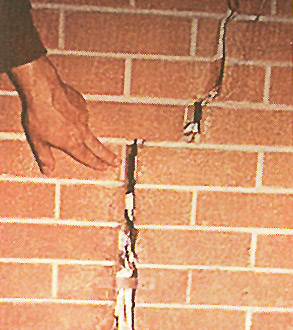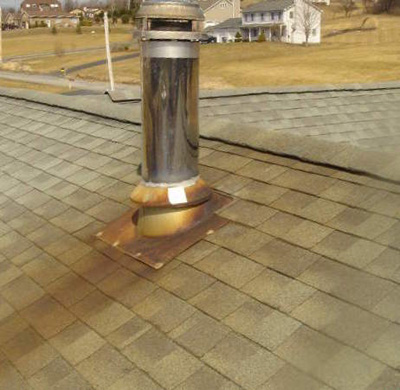CRACKS IN CHIMNEY
Cracks in Chimney
- How Cracks in your Chimney or Fireplace can lead to a Potential House Fire
-

-
When cracks occur in your chimney, hot gases can escape into the home and reach combustible materials that would otherwise be inaccessible. These gases can cause nearby framing or wooden structures to ignite. Cracks also allow other dangerous gases like carbon monoxide to enter your house. Once cracks are present, and a fire hazard exists, it’s only a matter of time before you will have a chimney fire. If you are “lucky”, gas entry and ignition will burn slowly because there is not much airflow so that only the chimney itself is damaged. If the fire has enough fuel, it will burn fast, hot, and loud! You will hear rumbling and popping coming from the chimney as well as see smoke exiting the roof from outside your house. This kind of chimney fire can spread ripidly and cause a lot of damage to your home. One final risk of a cracked chimney is a full on collapse, which can cause just as much structural damage to your house as a fire would.
- Professional Chimney Sweep Inspection for Cracks
-

- Gas entry and ignition, CO emissions, a chimney collapse, and drafting problems all caused by chimney cracking can be prevented by having your fireplace inspected for brick cracks, faulty cracking liners, water damage, and mortar cracks each year. A professional inspection for cracks typically requires your chimney sweep to place a camera on a string and run it along the entire interior of the flue with proper lighting to get an accurate view. They do this after fully sweeping the interior of creosote buildup. It will be much cheaper in the long run to have your annual inspection than if you should have a house fire occur. The reason why is because insurance typically declines to cover the cost of a house fire due to your own negligence which they discover when assessing the damage and find cracks.
- Causes of Cracks in Chimneys
-

- Cracks in your chimney are initially caused by a couple of different reasons. First, it is could be that you have a water leak because you have a defective chimney cap or chimney flashing, or you are missing a chimney cap or flashing altogether. If your cap or flashing is cracked itself, misshaped, or not draining properly, water can leak in. If water is leaking into your chimney, it can saturate the chimney bricks, mortar, or if you have a tiled chimney liner, it can saturate the tiles. With enough time, the water can damage and crack the brick. You are at even higher risk if you live in a climate that gets below freezing. Frozen water expands quickly and can cause cracks very quickly. A second reason you may experience cracks is that the chimney was constructed improperly from the start. If the chimney is not secured properly to the house, shifting and cracking to the chimney can happen as it settles. Thermal expansion is a normal process for your chimney, where the flue heats and slightly expands when a fire is lite. If the contractor did not build a large enough air space between the flue and the chimney itself, the flue can expand and crack the chimney bricks. Clay flue liners are especially susceptible to cracks so if you have clay and use your fireplace or heating appliance regularly, you definitely need to have it fully inspected often.
- Replacing a Cracked, Damaged Chimney Liner (AKA flue)
-
- Suppose you know that you have a cracked or damaged chimney liner and now you need to determine what to do to fix the problem. Depending on what type of chimney liner you have and the extent of the crack damage, your chimney sweep will recommend that you replace the broken clay tiles in the liner, smooth heat resistant mortar through the crack or open mortar joint, install a new clay tile liner, create a new flue by using one of several poured-cement processes, or run a new metal flue liner through your chimney. These methods all vary extensively based on the severity of the crack. If you have only one flue tile that is cracked near the top of your chimney, it can easily be replaced. If the crack is in a harder to reach spot, such as the middle of the liner, then using the heat resistant mortar is a good technique. If you have widespread cracks throughout, a full replacement will be needed. Stainless steel liners are the most expensive repair for the flue system. They are insulated, cut to fit properly, and dropped into the flue from the roof, creating a whole new flue system for the fireplace to vent through. This method is a guaranteed way to repair all your cracked chimney flue tiles and mortar joints. Always consult with a professional chimney sweep about what repair is most appropriate for your chimney liner. Each method has its benefits, limitations, challenges, and price differentials. The solution that you choose should be the one that is most suitable to the problems of the particular chimney liner you have and the heating appliances vented through it. Your chimney sweep will make sure to follow any manufacturer instructions and also follow all fire and building codes in your area.
- Repairing Cracked Bricks and Mortar through Tuckpointing
- If you notice that you have cracked bricks or missing mortar joints and it is isolated to a specific spot on your chimney, it may be possible for your chimney sweep to repair that spot without having to do an entire (and very expensive) remodel. Take a screwdriver to your mortar and if it crumbles away in the cracked area, it is time to all your professional chimney sweep. Make sure you discuss the possibility of tuckpointing with your chimney sweep before deciding on the solution you will use to repair cracking bricks and mortar. Tuckpointing is a process where the damaged portion of mortar and bricks are removed and replaced so that they blend in with the original masonry work. Chimney professionals have special tools to perform tuckpointing, such as standard, flat bottomed, square beaded, round beaded, stubnose, longnose and rounded corner tuckpointing tools. The process ensures that the joints between your bricks are strong and water-resistant, in addition to preventing any costly future repairs.
- Why you should check your Chimney for Cracks after a Natural Disaster (such as Earthquakes)
- Although the chimney is not a main thought of concern when one thinks about a natural disaster, chimneys are one of the first things to fail on your home when a natural disaster does hit. Tall, slender chimneys that terminate high above the roofline are a particular risk as are chimneys that are built with unreinforced bricks. Chimneys that have pre-existing cracks are even more vulnerable to collapsing than those that are structurally sound before a natural disaster. If you live in an area that is prone to tornados, hurricanes or earthquakes, the concern of a collapsing chimney is real. If you need proof, you should know that FEMA offers assistance to homeowners to help cover chimney damage. “After the 2001 Nisqually 6.8 quake near Seattle, half of the $6 million provided in the temporary disaster housing program was distributed to residents for chimney repair.” Not only do you have to worry about the damage to the chimney itself, but if it falls, it could land on another part of the house, or your car, and worst case, cause an injury. Even if you do not have a collapsed chimney, it is extremely important to have the structural integrity of your chimney inspected by a professional chimney sweep after an event occurs. You should definitely not use your fireplace or heating appliance until the inspection is done and you know your chimney is safe. If cracks do happen, it’s best to get them fixed immediately using any of the techniques covered earlier on this page. Your safety and the prevention of house fires and toxic gases entering your home are the top concerns of your chimney sweep.
